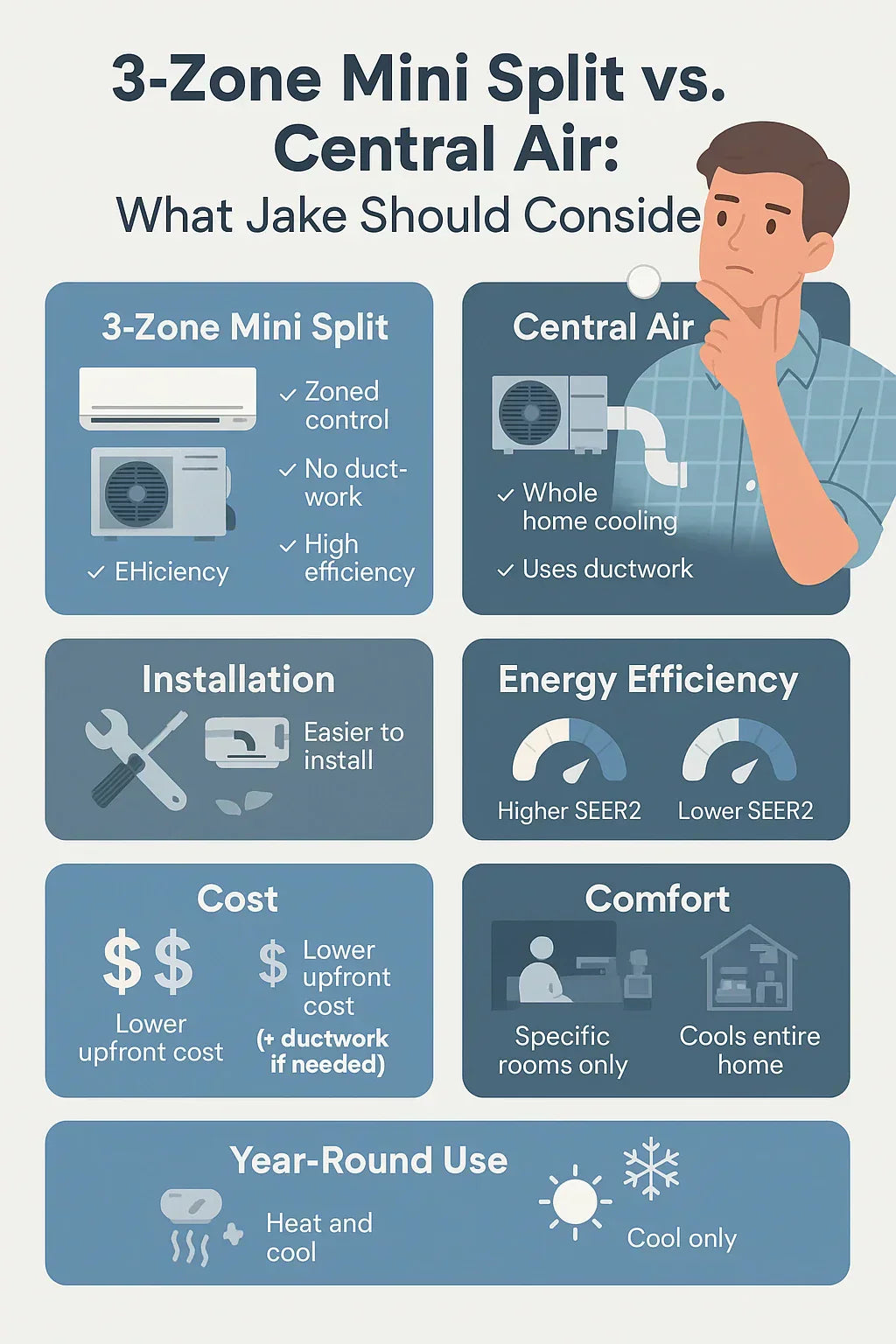Jake is a practical, research-driven homeowner who wants to make smart investments in comfort, cost-efficiency, and ease of installation. With the rise of ductless mini splits and the widespread presence of central air, the big question is: which is truly better for his home layout and long-term satisfaction?
This guide lays out every major consideration—performance, efficiency, install process, lifetime costs, aesthetics, and more.
🏡 What Are These Systems, Anyway?
Mini Split (3-Zone):
-
Ductless system consisting of one outdoor compressor and three indoor air handlers.
-
Each indoor unit independently heats or cools its zone.
-
Great for retrofits and room-by-room temperature control.
Central Air System:
-
One central condenser and air handler circulate air through a system of ducts.
-
One thermostat controls the entire home.
-
Ideal for homes with existing ductwork.
Learn more: EnergySage: Heat Pumps vs. Mini-Splits
🔧 Installation: Disruption vs. Convenience
Mini Split Pros:
-
No ductwork required
-
Wall-mounted or ceiling cassette units
-
Short install time (1–3 days)
-
DIY-friendly options like MRCOOL
Central Air Drawbacks:
-
Needs full duct network
-
Invasive retrofits in older homes
-
Always requires a professional HVAC team
Helpful Resource: LearnMetrics: Mini Split vs. Central Air
⚡ Efficiency & Energy Use
Mini Splits:
-
SEER ratings 20–30+ (some models hit 42)
-
Zoned control prevents cooling unused rooms
-
Less energy loss (no ducts = no thermal leakage)
Central Air:
-
SEER ratings usually 13–17
-
Air loss through ductwork can waste 20%+ energy
-
Limited zone control without expensive add-ons
Government Guide: Energy.gov: Ductless Mini-Splits
🏠 Zoned Comfort
Mini Split Wins:
-
Room-by-room control
-
Ultra-quiet indoor heads (~20 dB)
-
Customize temps based on activity and time of day
Central Air Limitations:
-
Even air distribution across house
-
Can overheat/cool certain rooms
-
May need zoning dampers (more complexity)
💸 Upfront & Lifetime Cost Comparison
| System Type | Equipment Cost | Install Cost | Avg Total | Notes |
|---|---|---|---|---|
| 3-Zone Mini Split | $3,500 - $6,000 | $0 - $3,000 (DIY vs. Pro) | $4k - $9k | Big savings if DIY |
| Central Air | $5,000 - $10,000 | $3,000 - $7,000 | $8k - $17k | High if no existing ducts |
Mini Split Edge: Lower install + higher efficiency = faster payback
Central System Edge: Better if ducts already installed
🎨 Aesthetics & Noise
Mini Splits:
-
Indoor units visible (wall-mounted or ceiling units)
-
Nearly silent (18–30 dB)
-
No duct rumble or pressure issues
Central Air:
-
All components hidden in attic, closet, or basement
-
Slightly louder (40–60 dB)
-
Uniform airflow may feel less personalized
❄️️🌡️ Heating & Cooling Versatility
Mini Split Heat Pumps:
-
Year-round solution (heating + cooling)
-
Performs well in mild and moderate winters
-
Cold climate models available
Central HVAC:
-
Usually cooling-only (paired with separate furnace)
-
Heating adds cost and complexity
Certifications: ENERGY STAR Heat Pump Directory
⚠️ Common Misconceptions Jake Should Avoid
-
"Mini splits are only for additions or small homes" ✘
-
"Central air is cheaper over time" ✘
-
"Zoning is too complicated" ✘
Mini splits are perfectly suited for mid-size and larger homes, especially if you want ultimate control and energy savings.
🔎 Jake’s Decision Tree: What Should He Pick?
-
Do I have ducts in place?
-
Do I want DIY installation?
-
Am I planning for long-term energy savings?
-
Do I prefer zone control and custom temps?
-
Do I live in a region with hot summers and cold winters?
If Jake answers yes to 3 or more, a 3-Zone Mini Split is likely the better call.
⚖️ Final Verdict
| Factor | Winner |
| Installation Simplicity | Mini Split |
| Energy Efficiency | Mini Split |
| Aesthetics | Central Air |
| Noise | Mini Split |
| Heating/Cooling Combo | Mini Split |
| Cost | Mini Split (especially DIY) |
| Best for Older Homes | Mini Split |
| Best for Large Homes w/ Ducts | Central Air |
🚀 Next Steps for Jake
-
Compare system specs from trusted brands (MRCOOL, Mitsubishi, Pioneer)
-
Explore financing if budgeting for professional installation
-
Check for local rebates or tax credits for high-SEER heat pumps
Jake’s home comfort journey doesn’t end here. But with the right 3-zone setup, it can start strong, efficient, and future-proof.
In the next topic we will know more about: Where to Mount Each Indoor Unit: Wall, Ceiling, or Floor Options







